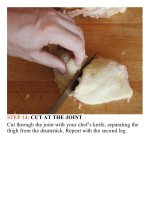The food lab better home cooking through science ( PDFDrive ) 473
Bạn đang xem bản rút gọn của tài liệu. Xem và tải ngay bản đầy đủ của tài liệu tại đây (177.84 KB, 2 trang )
vide. Think of the possibilities. Hotel rooms. Backyards.
Boats.Movietheaters.
ONFOODSAFETY
AnyonewhohastakenaServSafefood-handlingcoursehas
heardofthe“dangerzone”:thetemperaturerangebetween
40° and 140°F where bacteria supposedly multiply at
acceleratedrates.AccordingtoServSafedirectives,nofood
canstayinthatzoneforlongerthan4hourstotal.
Of course, this is strictly absurd. Imagine throwing out a
ripe Camembert just as it is finally approaching its optimal
serving temperature because it’s been on the cheese board
for a couple of hours. Or think of throwing outjamóns
Ibericoorprosciuttoorevenagoodoldcountryhamjust4
hoursintoitsmonths-longcuringprocess,allofwhichtakes
placeinthisso-calleddangerzone.Smallfortunes’worthof
dry-aged beef would have to be chucked in the bin to
complywiththesedraconianregulations.
ServSafe rules, along with the rules set by the U.S.
Department of Agriculture, are intended to absolutely
eliminate the possibility of food-borne illness—they are
designed to have a large margin for error, as well as to be
simpletounderstandattheexpenseofaccuracy.Inreality,
anynumberoffactors,includingsaltlevel,sugarlevel,and
fat level, as well as water content, can affect how rapidly
food will become unfit to consume. Not only that, but
temperatureandtimehaveamuchmorenuancedeffecton
foodsafetythanweareledtobelieve.
When we talk about fresh food—particularly meat—
posing a health hazard, what we’re really talking about is
bacterial content and the toxins they can produce.As meat
sits, bacteria present on its surface will begin to breed and
multiply, eventually growing to a dangerous level. Below
38°F or so—fridge temperature—the bacteria are lethargic,
multiplying very, very slowly. Take the meat all the way
down to freezing temperatures, and the water necessary for
thebasiclifefunctionsofabacteriumturnintoice,making
it unavailable to them.That’s why frozen meat can last for
months,evenyears,ifproperlysealed.
But when meat gets warmer, the bacteria become more
and more active, and they will continue to do so until
they’vegottensohotthattheydie.Thiskill-temperaturecan
varyfrombacteriumtobacterium,butingeneralit’saround
120°F, with the very hardiest (Bacillus cereus) finally
kickingthebucketataround131°F.
Ah,you’rethinkingtoyourself,soIonlyneedtocookmy
meat to 131°F for it to be safe.Well, yes and no. Just like
cooking, destroying bacteria—the process of pasteurization
—takes both temperatureand time to accomplish. (See
“ChickenTemperatureandSafety,”here.)
With a temperature-controlled water bath, you have the
abilitynotonlytocookchickentolowertemperatures,but,
moreimportant,toholditthereuntilit’scompletelysafeto
consume.
Whatdoesthismeanforahomecook?Itmeansthatyou
nolongerhavetoputupwithdry165°Fchicken.
Achickenbreastcookedsous-videto140°Fandheldfor
25 minutes is just as safe as chickencooked to 165°F, and
incomparably moister and more tender. It glistens with









